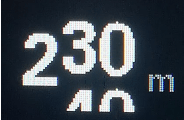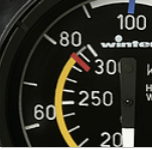Altimeter, Airspeed #

This can be used to set parameters for the altimeter (altimeter) and the sensor for the displayed speed (IAS), and to zero the airspeed sensor.
Altimeter Source #
[TE Sensor] [Baro Sensor]
Either the [TE Sensor] or the [Baro Sensor] can be selected as the source for the altimeter. The baro sensor is preset. The TE sensor only makes sense if you want to have the energy level displayed, or for test purposes.
AS Calibration #

0 %
With the AS Calibration, a proportional calibration of the “Air Speed (AS)” or flight speed can be carried out. The calibration can be set in 1% steps in the range of +-10%. For example, with a calibration of +5%, instead of 100, 105 km/h will be displayed. This is normally not necessary, as the accuracy of the sensor is usually completely sufficient, however, the pressure readings in the aircraft can run incorrect values, and so there is an option here to minimize these errors. Default is 0% calibration. The AS calibration calibrates the respective value according to the setting IAS/TAS.
AutoZero AS Sensor #
[Cancel] [Start Autozero]
With this option, the zero point of the airspeed sensor can be re-calibrated. The high accuracy of the airspeed sensor is ensured by a daily calibration of the zero point. This is normally carried out automatically on the ground when the power is turned on and is therefore only necessary in exceptional cases. At low speeds < 30km/h, very low pressures are relevant, different wind pressures from a gust or the propeller on the statics or the pitot tube when switching on can possibly lead to a deviation. If the display on the ground does not show exactly zero due to an incorrect zero point, this can be a remedy.
Alt. Quantization #

[Disable] 2 5 10 20
This item allows you to choose to what extent the altimeter display is quantized to an interval of 2-20 meters (or 6-60 ft), as shown in the graph to the right with 10 meters. The two digits then move up (rise) or down (fall) like on a counter wheel, which significantly improves readability when the flight altitude is in motion compared to the simple digital display.
Stall Warning #
The stall warning gives a visual and audible warning of an impending stall. The set stall speed, the load and, if the AHRS option is available and enabled, also the load factor are decisive. For example, the stall speed increases by 41% in a banked turn with 60 degrees and a load factor of 2 g. The stall warning can be helpful in flight phases with a high workload, e.g. when approaching in gusty weather, or when circling in thermals. The warning is given by a screen with the red lettering “! STALL !” and a triangle pointing downwards, which means that there is a visual indication of a hold-up and an acoustic warning signal.
The stall warning will not activate until the aircraft first reaches stall speed.
Stall Warning #

[Disable] [Enable]
The feature can be switched on or off with this. By default, the stall warning is disabled with [Disable].
Stall Speed #
70 km/h
By default 70 km/h is set for the aircraft without additional load which fits many standard gliders like LS4 and similar. For other types of aircraft, the correct stall speed can be found in the flight manual and set here. The warning is triggered from stall speed and slower, down to minus 30% of stall speed.
Maximum Speed #

270 km/h
By default, 270 km/h is set as the highest speed (IAS, indicated airspeed), which the instrument specifies for the target flight. This must not exceed the maximum permitted speed for aircraft.
Caution: The default value should be checked and adjusted if the value in the flight manual deviates from the default.




